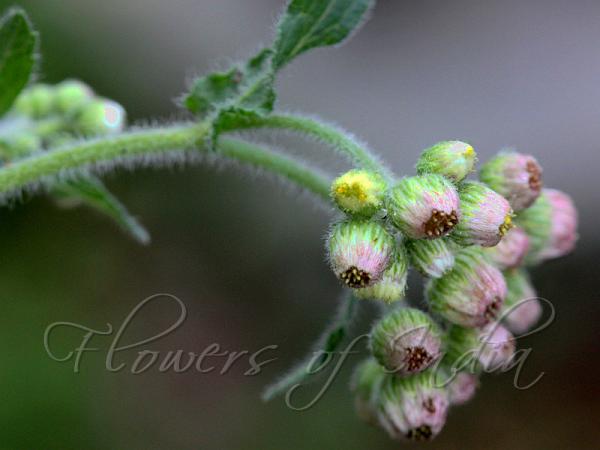|
| Japanese Fleabane |
|

|

| File size | 116189 |
| Original date | 6/2/13 4:05 PM |
| Resolution | 800 x 600 |
| Flash | Flash did not fire |
| Focal length | 100.0mm |
| Exposure time | 1/160s |
| Aperture | 5.6 |
| Focus Distance | |
| Metering Mode | Multi-segment |
| Camera make | Canon |
| Camera model | Canon EOS 550D |
| Sensor type |
|
|
|
|
Photo: |
Botanical name: Eschenbachia japonica Family: Asteraceae (Sunflower family)
Synonyms: Conyza veronicifolia, Conyza congesta, Conyza japonica
Synonyms: Conyza veronicifolia, Conyza congesta, Conyza japonica
Japanese Fleabane is an annual or biennial herb.
Stems are erect, grayish green, 25-55 cm tall, channeled, often
branched in upper part, hairy. Leaves are obovate to spoon-shaped,,
2-6 x 0.75-1.5cm, pointed or blunt, narrowed at base, sawtoothed in the
upper half, velvet-hairy on both suffaces; basal leaves with a leaf-stalk
up to 2cm; stem leaves stalkless, semi-stem-clasping. Flower-heads are
several in compact at branch-ends corymbs; involucre 3-5 mm diameter;
phyllaries 2-3-seriate, lanceshaped, 3-4 x 0.5-1mm, outer and middle ones
velvet-hairy on the back. Flowers are white at first, later turning purple.
Female florets are estrap-shaped, 1.5 mm; style 2.5 mm. Bisexual flowers
2.5 mm. Achenes are obovoid, 1 x 0.5 mm; pappus 2.5 mm, white or reddish.
Japanese Fleabane is found in Afghanistan, W. Pakistan, India, Himalayas,
Burma, Thailand, Indo-China, Malaysia, China, Japan, at altitudes of 600-2600
m. Flowering: March-September.
| Identification credit: Gunjan Sud | Photographed in Chopta, Uttarakhand. |
• Is this flower misidentified? If yes,